Words by Adam
Translation by Hiba Moustafa
Design by Lina A
After I met a person with a disability for the first time, I was struck by my own ignorance and failures about the reality of life in the community. The fact that it took until adulthood to meet someone with disabilities is strange, as 13% of Jordan’s population has some sort of disability (including motor impairment and intellectual disabilities). However, parents try to hide these disabilities and there is a general lack of facilities to support these people in the country, leading to more prominent problems that hinder participation in society. And, there is a lack of resources in the Arabic language that even discuss the topic.
One issue that people with disabilities face is how their sexual needs and desires are downplayed and delegitimized by their families, communities, and society more broadly. Myths about the sexual desires of disabled people, in addition to other prejudices and stigma, can cause embarrassment about getting close to people. In Germany, I saw two people with Down’s syndrome on a train hugging tightly, which made me wonder about the myths that we hold about disabled people in the region.
This article aims to dissect and refute these stereotypes regarding sex and sexuality of people with disabilities.
MYTH #1: People with disabilities don’t have sexual desire(s)
Assuming that all persons with disabilities are asexual reduces their sexual and non-sexual diversity. World Health Organization (WHO) acknowledges sexuality as a human basic need that cannot be separated from other life aspects. Some people with disabilities may be asexual, but this is not an inevitable consequence of their disability.
The common belief that all persons with disabilities are asexual, however, creates barriers to their conception of sex, which reduces their sexual knowledge and access to sex education, compared to their non-disabled peers. Consequently, they are more vulnerable to “exploitative sex” including prostitution, pornography, sexual violence, unintended pregnancies, STIs, etc.
Studies have shown that persons with intellectual disabilities have sexual desires just like everyone else. The only difference is that some of them may need or awareness, depending on the form and type of disability. For example, most people with intellectual disabilities have satisfying relationships, yet some of them may need additional support to develop these relationships in order to choose and express their sexual orientations and have access to sexual health information and services.
MYTH #2: Persons with disabilities are only attracted to people of the opposite sex
People with disabilities have various sexual desires, including identifying as LGBTQ+ or queer.
There are various physical, biological, and social aspects to sexual activity, and each person has their own way of understanding and interpreting their sex life. This changes over time, and what matters is understanding and respecting others’ needs with all their diversity.
MYTH #3: People with motor impairments cannot have sex because of their disability
People with a disability may have low confidence before having sex or even thinking about it. Some may think that their disability may weaken their physical ability and, by extension, their ability to engage in sex regularly. Even if this were true in some way, it misses the fact that most people feel anxious about their sexual performance, which is normal and depends on understanding our partners and ourselves. In other words, the sexual needs and “capacities” of people with disabilities vary, as is the case with everyone else. This recognition may make us reconsider what we define as sex and “having sex” (only penetrative or procreative?), what it means, and the range of what satisfying intimacy or sexual pleasure might look like for different people. Further, it makes us consider what consent and safety look like in this setting.
MYTH #4: People with disabilities only have sex with one another
What people find attractive or sexy varies, and desire is informed by a number of elements, including personality, personal history, values, appearance, sexual orientation, or the time or moment.
Not only is attractiveness not something universally agreed upon, but we don’t fully understand what, how, or why we love.
The notion that people with disabilities should only date one another is based on the likelihood that two such people would meet. But, “defining” a person or their desires on the basis of their disability is irrational; people can enjoy a healthy sexual relationship if and when they have pleasure, feel safe with each other, and agree to the form of sex they are having. To understand an able-bodied person dating a person with a disability as an act of heroism assumes that they have the upper hand and that the person with the disability is weak or dependent. Furthermore, it assumes that people with disabilities are not desirable in their own right, at least not to able-bodied people.
All relationships require a huge effort by the two parties to succeed, and having a disability doesn’t mean that the person is less capable of making it work. It just might mean that the way they contribute may differ or they may have to navigate a particular set of limitations. The best person to define the form of this kind of contribution is often the individual, depending on the form and nature of the relationship, and each person should have the opportunity to know their body and needs, and to learn how to cope with different situations.

